The best Croatia road trip stretches the full length of this magical country of red tiled roofs, friendly people, and clear, turquoise sea. While there’s never enough time, based on our own recent experience road-tripping Croatia—I recommend at least two weeks.
That’s just enough time to start in the north near Rovinj, visit an island, and make it down to Dubrovnik, one of the world’s best-preserved medieval cities, in the south.
When we visited, we flew into Zagreb, rented our car there and headed to Lake Bled, Slovenia first. We drove round-trip which was A LOT of driving so if you want to make it all the way to Dubrovnik in the south, I recommend looking for open-jaw plane tickets instead.
In other words, you could fly into Zagbreb and home from Dubrovnik (or vice versa doing this itinerary in reverse) and save yourself a whole lot of extra driving.
Open jaw airline tickets can cost more as do one way car rentals but they can definitely be worth the extra cost when your vacation time is limited as they save so much driving leaving more time for fun!
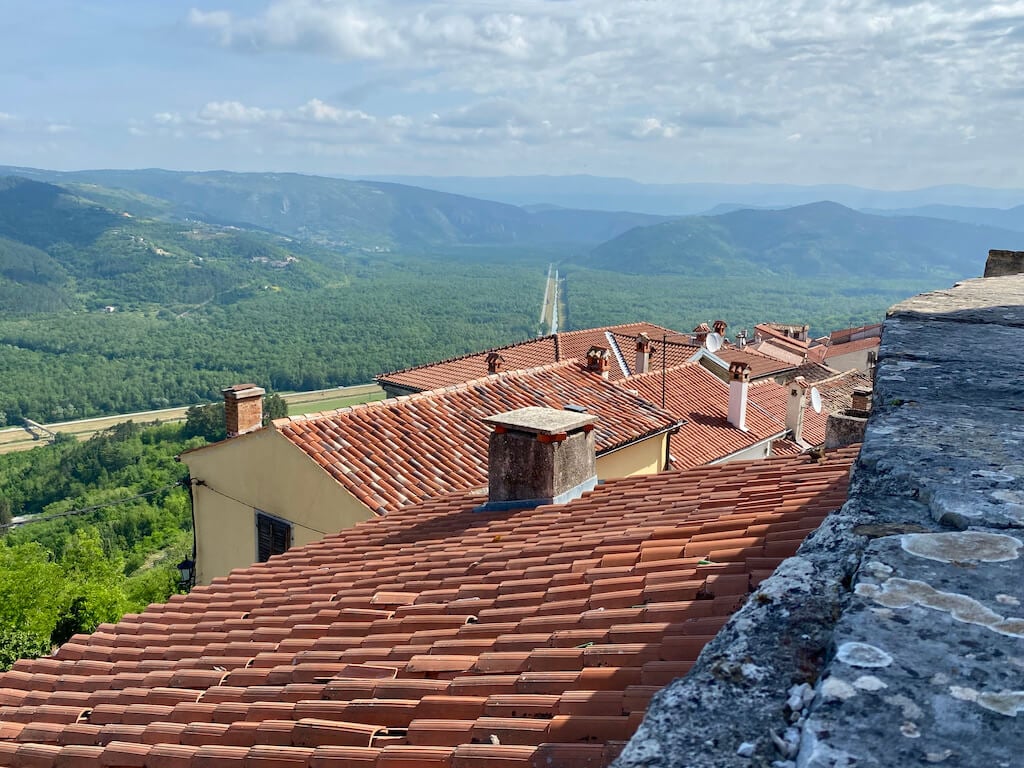
Croatia by Car
With a two week Croatia road trip, I’d recommend two days in Rovinj, two days in Plitvice National Park, one day in Split, three days on Korcula or island hopping (we only went to Korcula), and two to three days in Dubrovnik.
Then you have three or four days left to either start and end in Zadar (with one extra night in Split halfway for your return to Zadar if driving round-trip as we did) or a few days to dip into Slovenia with a stay in Lake Bled and Ljubljana.
With just one week, I’d focus on Split, Dubrovnik and either Korcula or Hvar Island (a popular alternative to Korula).
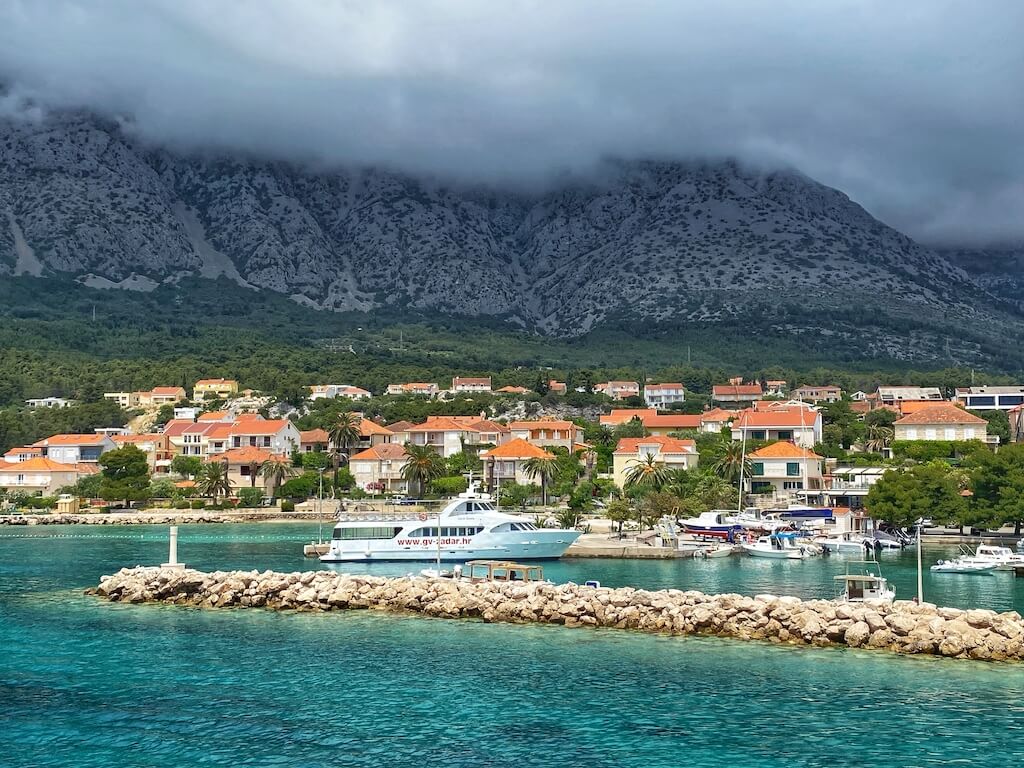
With less than two weeks, head directly to Split and focus your time on the sun-drenched Dalmatian Coast.
A quick plug for Slovenia: Our few days in Slovenia were simply stunning and were also a natural add-on when driving between Zagreb and Rovinj.
A few things you might not know about Solvenia: It’s affluent.
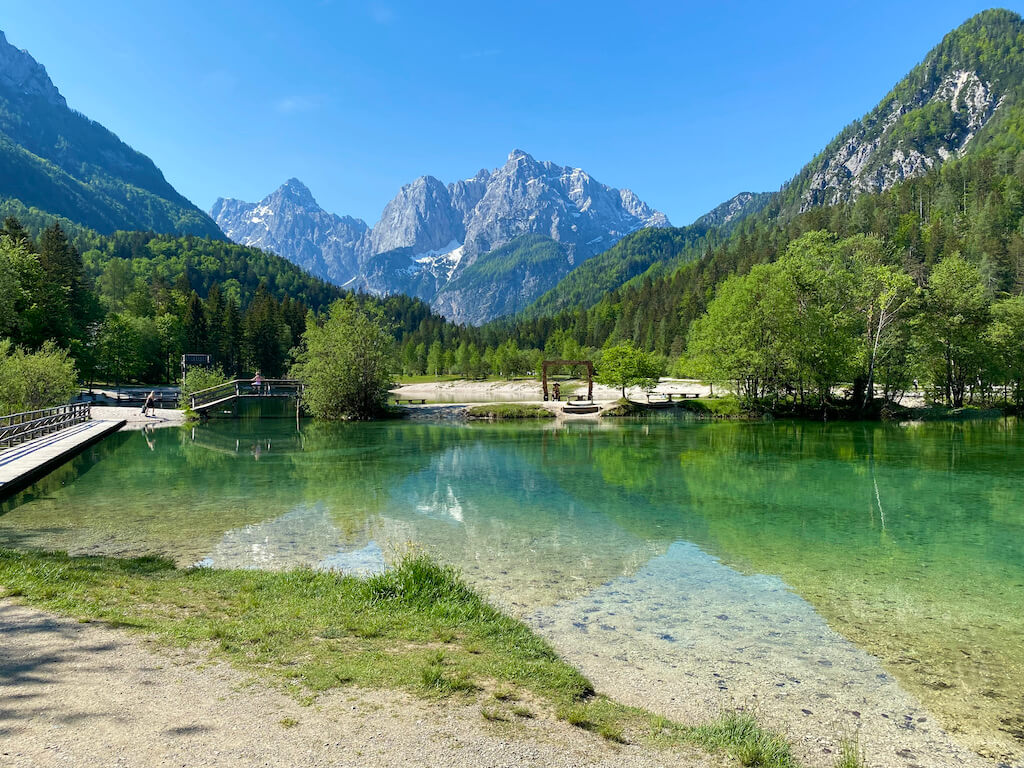
It’s not cheap for a country to join the EU but Slovenia did it back in 2004; Croatia not until 2013. In fact, Croatia is still using its local currency the Kuna until January 2023.
We found Slovenians to be easy-going, speak excellent English, and ski fanatics! (It seemed like almost everyone skiied. It wasn’t an activity reserved for wealthier people like it can be in the U.S.)
Slovenia is clean, leafy, and green with its dramatic Julian Alps. To me, it looks a lot like Austria (no surprise as Austria’s border is just north of Lake Bled) with better prices.
Plus, in my experience, the beds are way better than in Croatia.
Sure, you’ll find lots of country fare with dumplings in the Slovenian countryside but in its capital city of Ljubljana and other tourist hot spots, expect inventive cuisine, plenty of fresh fish, and lovely white wines.
Steve wouldn’t want me to neglect mentioning the excellent Slovenia beers—lagers—here either!
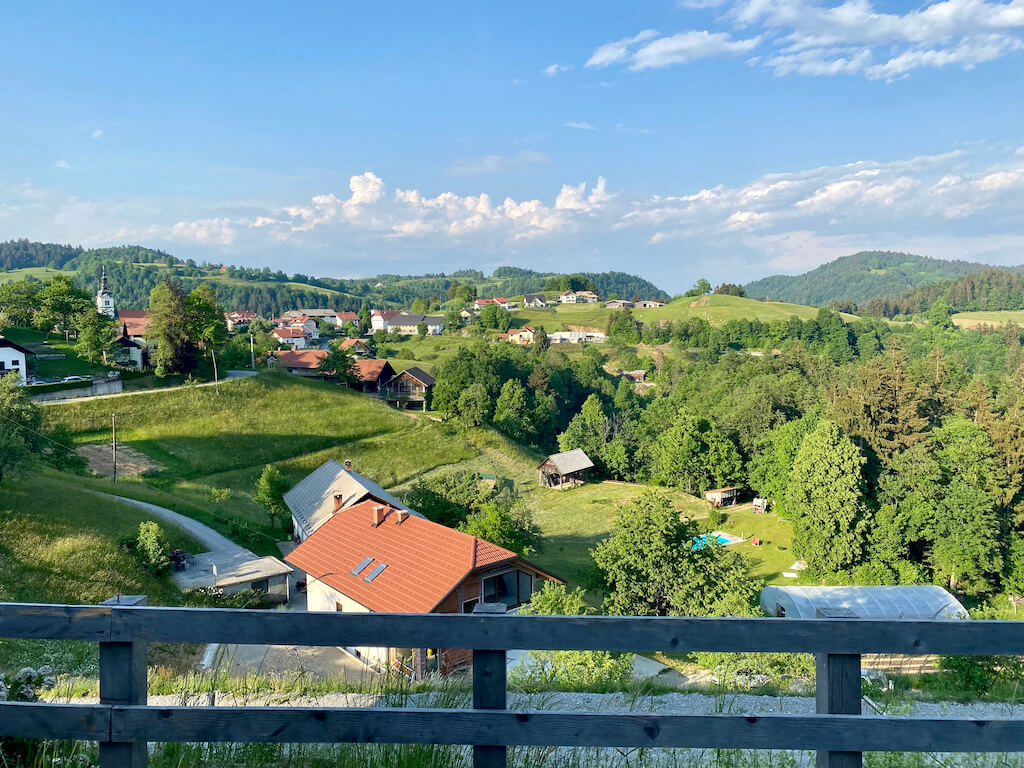
How to Rent a Car in Croatia
Discover Cars has no hidden fees, 24/7 customer service, and free cancellation. They search all the major rental car companies so you don’t have to.
Check price and availability on rental cars in Croatia here.
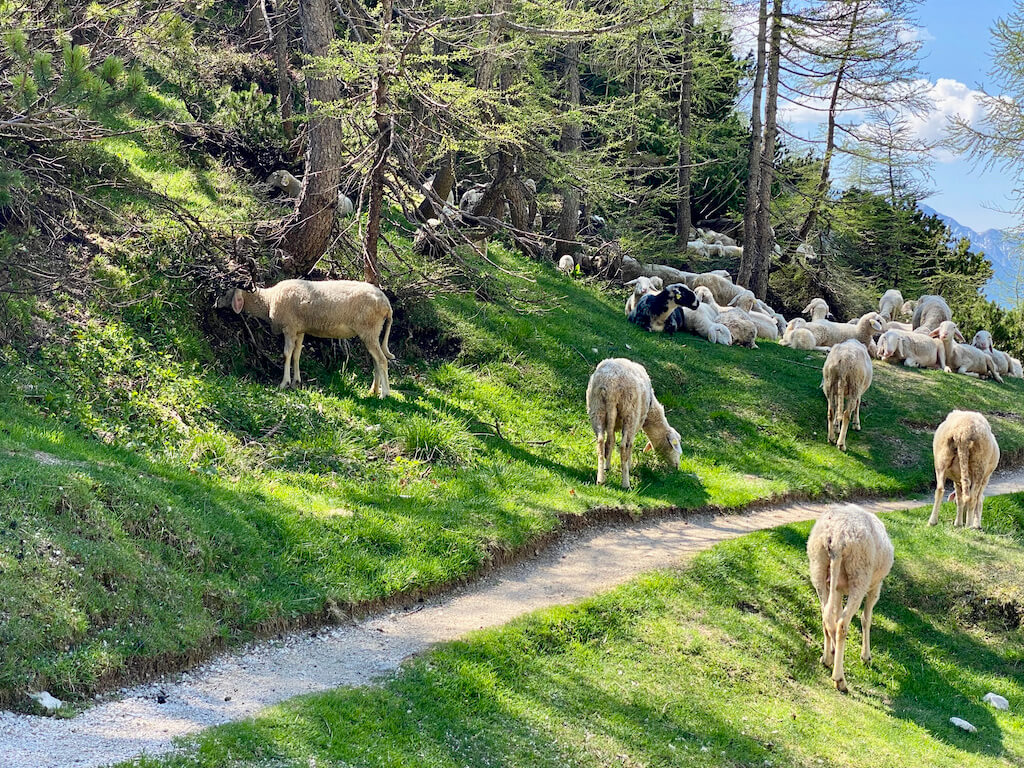
Slovenia is not cobblestone Europe, however. While there are some medieval towns, much of it is quite modern.
Lake Bled, the Julian Alps and Ljubliana are all in Slovenia but conveniently en route to Croatia from Zagreb’s airport.
Start your itinerary with a night in Zagreb and then head directly to Rovinj if you’d like to only visit Croatia.
Map of Croatia Road Trip Itinerary
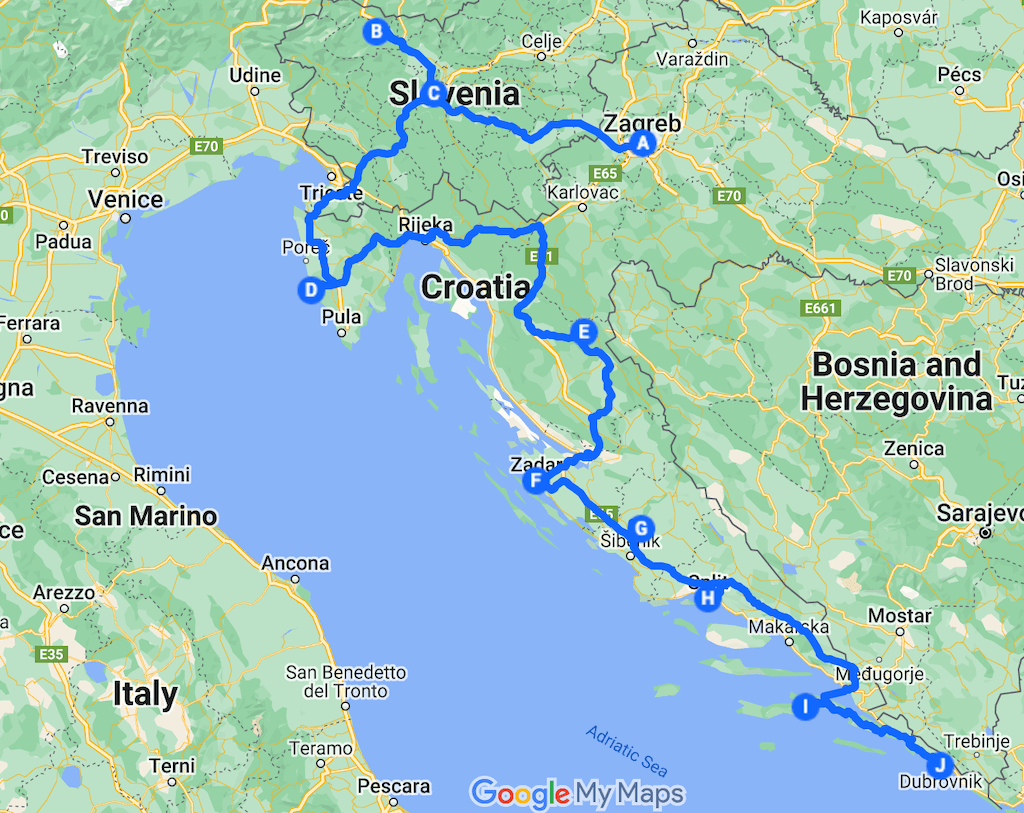
How to use this map: This map is an image. Click the map to open an interactive version of the map. From there, if you click “open in my maps”, you can add this to your Google maps. Just click the tiny transparent star to the right of the map description to save it in “your places.” Go to “your places” next and there it is!
Optional Slovenia Start to Trip
Start in Lake Bled
We flew into Zagrab—a gorgeous, modern, uncrowded airport—picked up our rental car and headed straight for Lake Bled in Slovenia, a two hour drive.
We didn’t spend any time exploring Zagreb on this itinerary but if you love cities, absolutely add a day or two there.
The only thing to know about driving in Slovenia is that you’ll need a “vignette” to drive toll roads legally.
In theory, you can stop in the last city in Croatia before you hit the Slovenian border and purchase one but we found it far more straight forward to just buy one online.
Fines are stiff for driving without one so don’t risk it!
You’ll drive through two passport checks (Croatia and Slovenia) and one toll both before you arrive in gorgeous Lake Bled. And once you do, you may never want to leave.
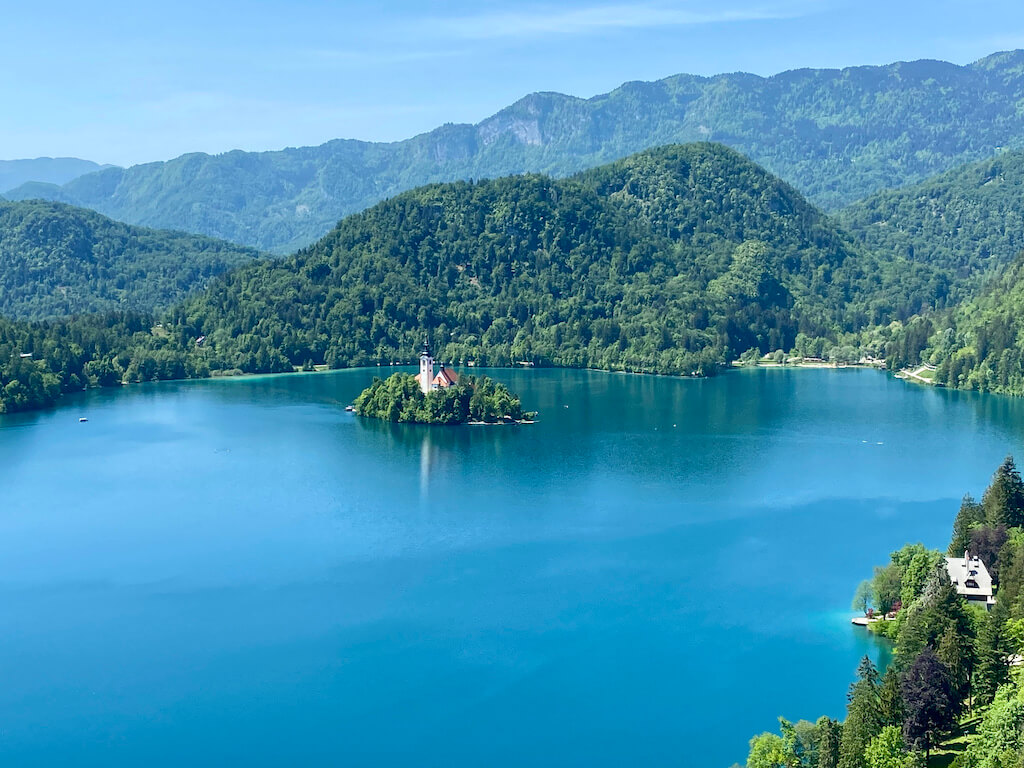
It’s a perfect spot to recover from jet lag as it’s just so peaceful!
It gets busy here in summer so I advise visiting in shoulder season—May or September—if you’re looking for a quiet escape.
The main things to do here? Walk the loop around the lake and take a boat trip or canoe ride out to the Church of Mary the Queen (Our lady of the Lake) which is on an island in the middle of the lake.
It’s 99 steps up a staircase to the church and if you make it to the top, you can ring the “wishing bell”—three times for good luck! In fact, you’ll hear the bell echo gently all day around the lake as a result!
Be sure to climb up to medieval Bled Castle while you’re here, which dates back to 1004.
It sits on a precipice high above the lake and is a great place for lunch or dinner with a view. (Be sure to reserve in advance.)
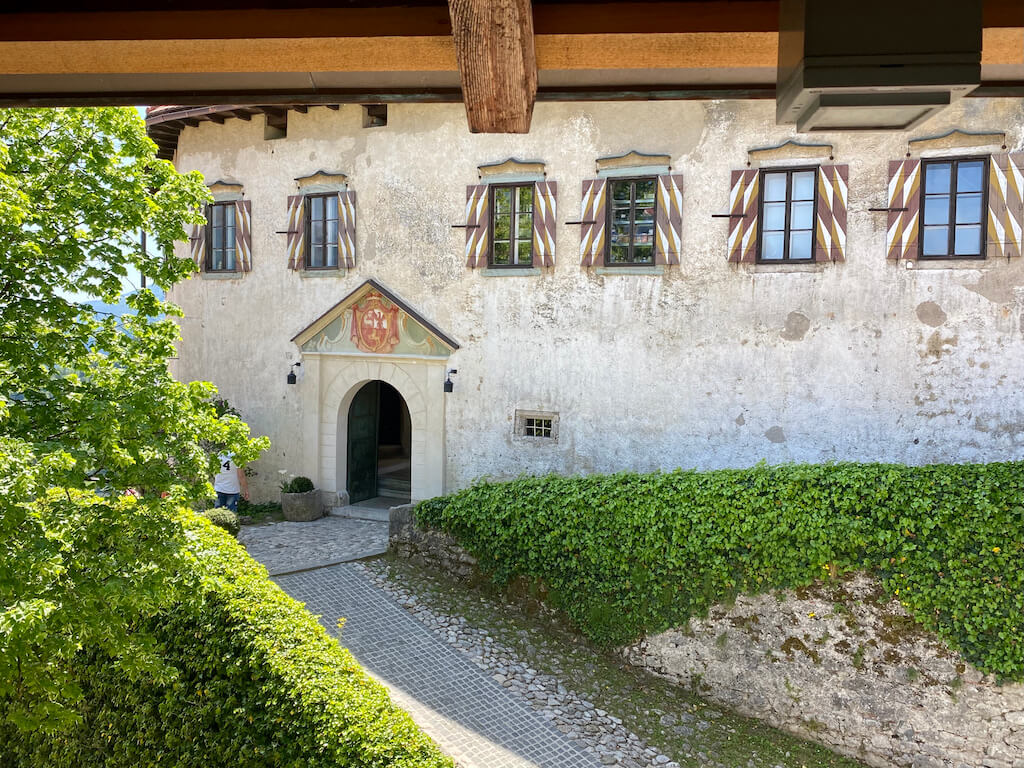
Where to stay in Lake Bled
Stay at Adora Luxe Hotel
This was a bit of a splurge but it was our favorite stay of the whole trip! The historic Adora Luxe Hotel is just across the street from Lake Bled and came with a private terrace with the view below.
I highly recommend reserving the optional breakfast…pastries, eggs, fruit, coffee, juice, and so much more. Truly unbelievable and worth every penny.
Check price and availability at Adora Luxe Hotel here.
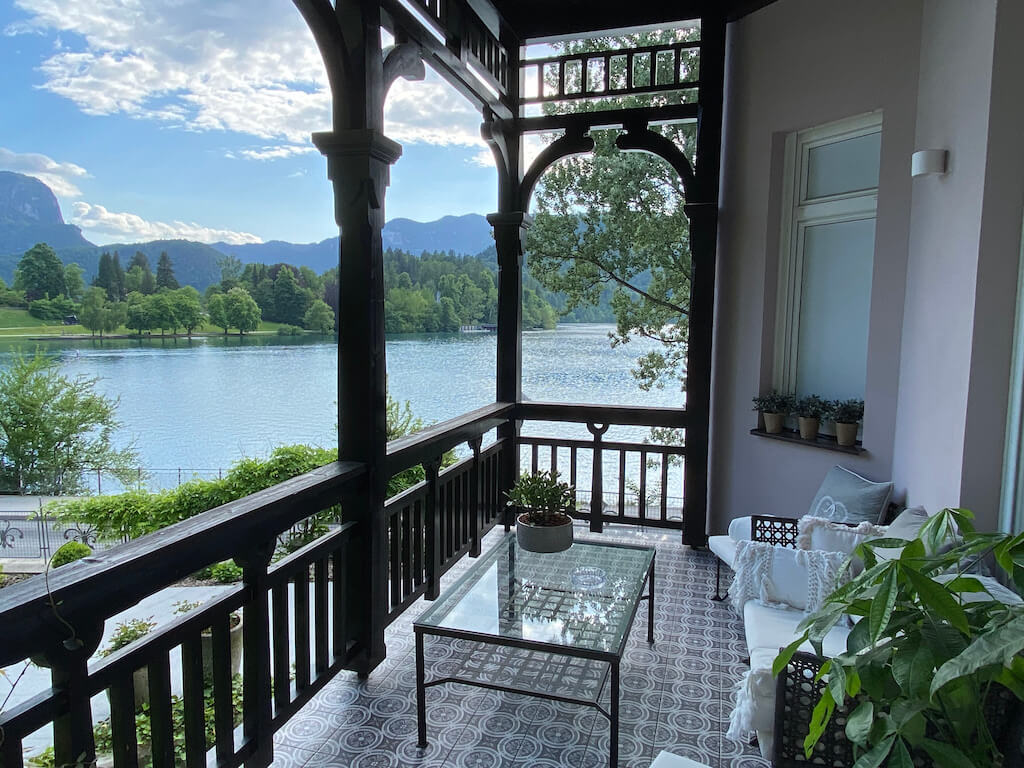
Drive the Julian Alps
Slovenia’s Julian Alps are part of the Southern Limestone Alps that stretch between Slovenia and northeastern Italy.
If you’re a nature lover, you shouldn’t miss the opportunity to drive this incredibly scenic stretch.
You can dive the Vršič Pass Loop as a day trip from Lake Bled or en route to Ljubljana as we did in one long, beautiful day.
Plan on about five hours of driving…or more if you want to stop for a scenic hike or a drink at a mountain cafe as we did.
You’ll wind your way past the ski resort town of Kranjska Gora (where most Slovenians yearn for a vacation home…you’re also quite close here to both Italy and Austria) and then up into Triglav National park up 24 hairpin turns.
Check out all the Slovenian cyclists huffing and puffing up to the top of Mount Triglav (“Three Heads”) on road bikes!
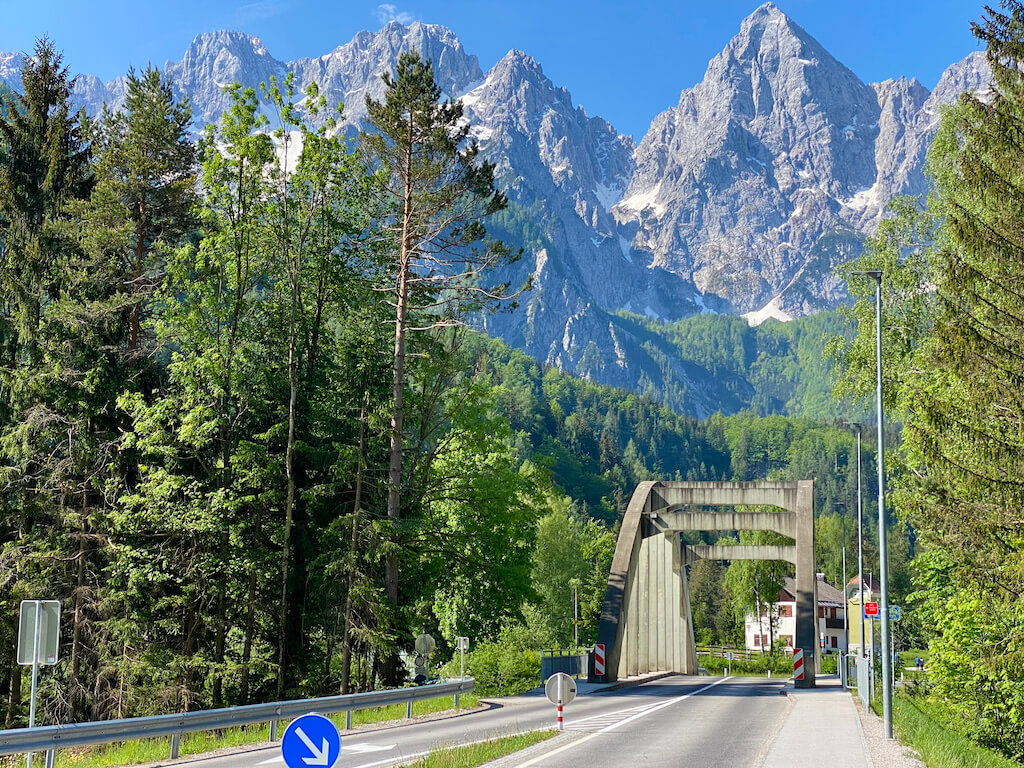
There’s a nice stop at a Russian Orthodox Chapel along the way that was built during WWI by Russian POWs and plenty of mountain huts where you can pause for a rustic meal, tea or a beer.
Then it’s down 24 hair pin turns into the incredibly scenic Soca Valley with the turquoise Soca River running through it.
We stopped for lunch in tiny Bovec, popular for adventure sports like running the rapids on a kayak, skydiving, and paragliding!
After that, consider stretching your legs with an easy hour-long out and back hike along the clear, turquoise Soca River to the Great Kozjak Waterfall.
Even if you don’t have time to make it all the way to the waterfall (which also requires you buy a 4€ ticket), the free portion of the hike is absolutely gorgeous!
Stop in Ljubljana
Slovenia’s capital city Ljubljana is all about the riverfront outdoor café scene that stretches through Old Town along the Ljubljanica River.
It’s a great place to people watch as you sip a coffe or enjoy a meal.
This city feels young and alive, full of artists, university students, and up and coming chefs.
In fact, on Friday nights in summer, the city hosts “Open Kitchen'” which features dozens and dozens of food market stalls, where the city’s most inventive chefs cook innovative, delicious fare.
Don’t miss it if you head to Ljubljana!
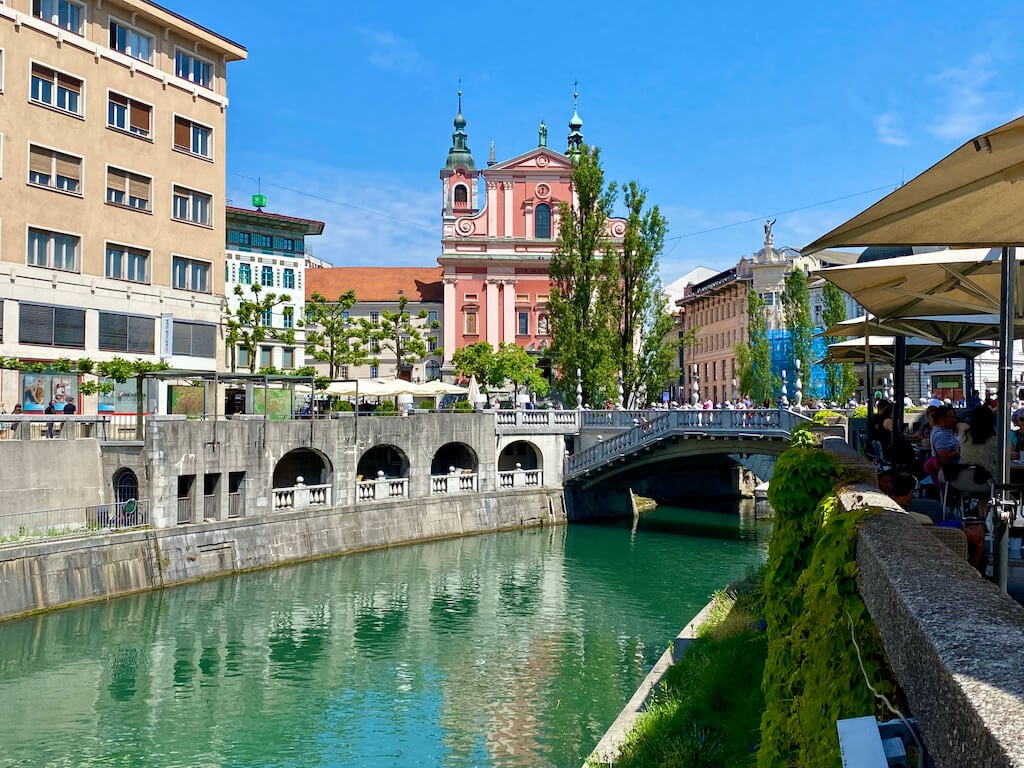
Where to stay in Ljubljana
Stay in a boutique hotel in Old Town.
The Adora Hotel (not to be confused with the one in Lake Bled above) is everyone’s favorite family-run boutique hotel steps from the Ljubljana River in Old Town, just beneath the castle.
Breakfast in the garden or taste test fine Slovenian wines at the bar. Walk everywhere you want to go.
Check price and availability at The Adora Hotel in Ljubljana here.
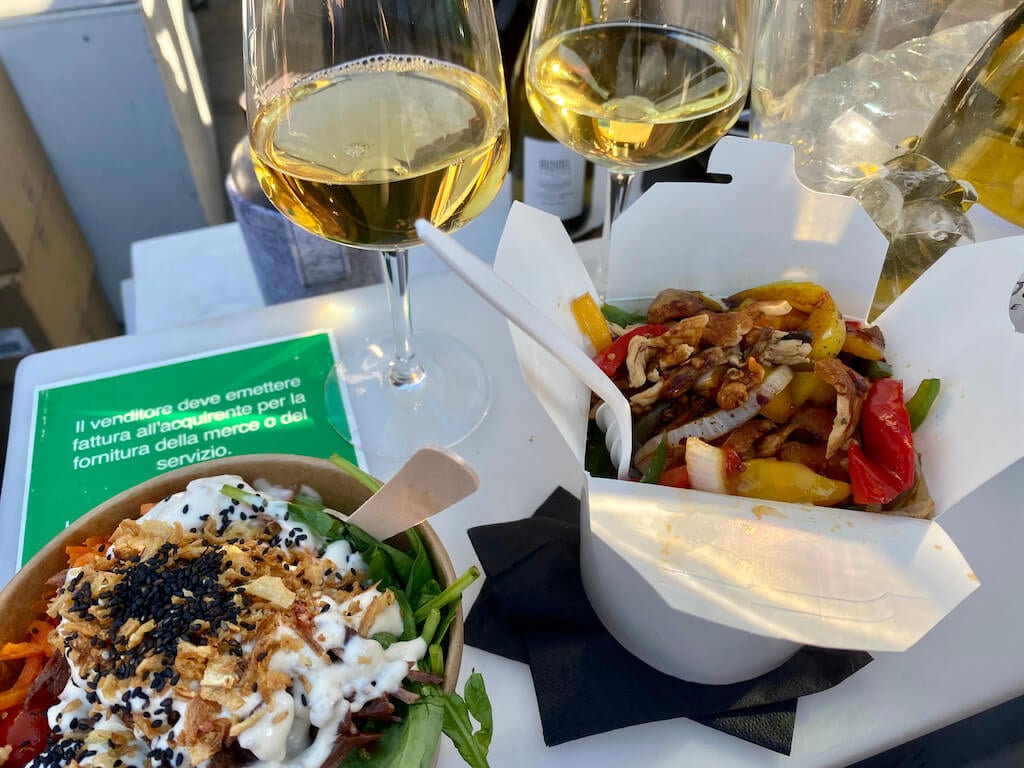
Ljubljana makes a great one night stop, in my opinion but not more. It’s a nice city but it’s not Paris or London! The riverfront is the main attraction here.
Ljubljana Castle, once an 11th century medieval fortress, is also fun to wander around.
Insider tip: We enjoyed a memorable Michelin dinner in a log cabin on an organic farm at Gostišče Gričs, about a 40 minute drive into Ljubljana’s countryside; it’s absolutely worth the drive.
On to Istria at last!
Croatia’s Istrian peninsula juts out into the Adratic sea and feels distinctly Italian. In fact, Istria’s changed hands so many times throughout history (Romans, Habsburgs, Franks, Venetians, etc., etc.) that the people who live here identify more as Istrians than Croatians today.
On a clear day, you can see Venice from Rovinj here. (You can also book a full day sailing trip to Venice from Rovinj!)
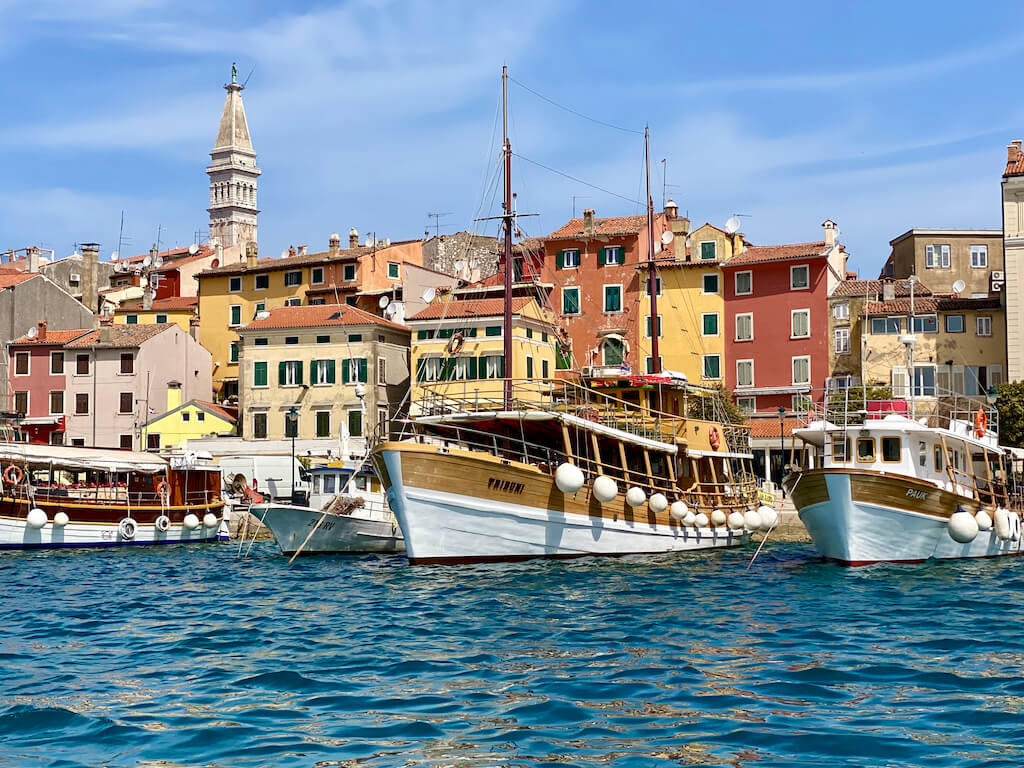
One of my favorite ways to break up a long drive (okay…it’s only a little over two hours to Rovinj from Ljubljana, but still…) is to make a lunch reservation for somewhere special en route.
And this is how I ate one of my top three favorite meals during our few weeks in Croatia.
A “konoba” in Croatia essentially means “tavern”. Just as Italy has its osterias and trattorias, Croatia has its konobas. But they are so much more.
As the soul of Croatia, konobas often feature simple furnishings, long wooden benches and invariably, excellent traditional national dishes.
It’s why we made lunch reservations to sample Istrian cuisine at Stari Podrum in Momjan on our drive to Rovinj.
Google maps got us completely lost so give yourself extra time if you go but it’s worth the headache.
I had this lovely rare steak smothered in arugula and shaved cheese which I’m still thinking about weeks later.
Plus, there’s a really special winery practically next door. (Email to reserve a tasting ahead.)
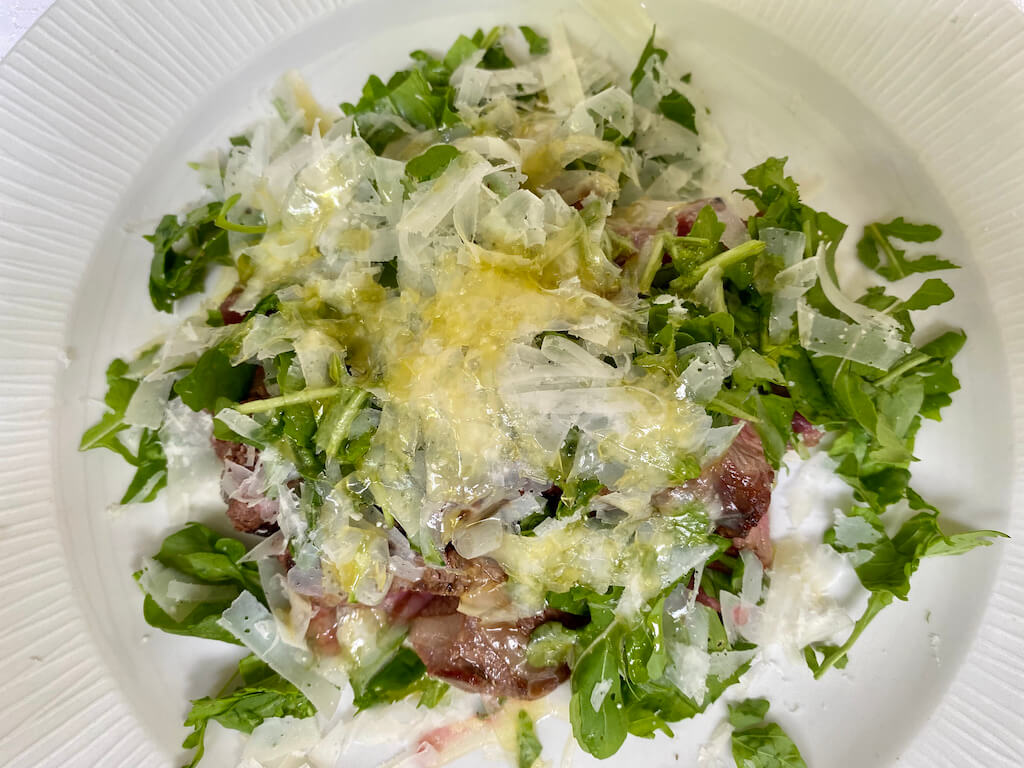
Rovinj
Rovinj is a romantic fishing port built on a headland in the Adriatic. Old Town is a jumble of ancient color washed stone houses that looks a lot like Italy’s Cinque Terre…except without the crowds.
In fact, cruise ships don’t visit Rovinj just yet but a big harbor expansion and renovation is planned soon so it may be just a matter of time.
Get here while you can still wander the narrow stone alleys relatively crowd-free.
Spend at least one day window shopping the boutiques, strolling the picturesque harbor, and climbing the bell tower at the Church of St. Euphemia for panoramic views of the red tile roofs and the sea.
If you’re here when the water’s warmed up—starting in June—this is a great place to schedule beach time.
In fact, you’ll see little hand rails that descend past the limestone directly into the sea next to the Mediterraneo Bar, which is a great place for a sunset cocktail.
With more time, consider hopping a sailboat cruise to one of the nearby islands.
We took a 5 minute ferry ride over to Katarina Island for lunch at the grand old hotel there and a bit of beach time but you could also explore the Brijuni Islands or Red Island as well.
Rovinj is also the place to order Italian fare. (Reserve ahead for Tutto Bene…which also made my list of top three meals, on my birthday no less.)

Where to stay in Rovinj
Stay at Hotel Casa Garzotto in Old Town.
It’s about location, location, location when choosing your base in Rovinj. Hotel Casa Garzotto oozes ambiance with its stone walls and romantic window shutters. It’s central but quiet and is just 1,000 feet from St. Euphemia’s Basilica. Plus, it’s a steal!
This place is better than where we stayed and comes with free parking.
Check price and availability at Hotel Casa Garzotto in Rovinj.
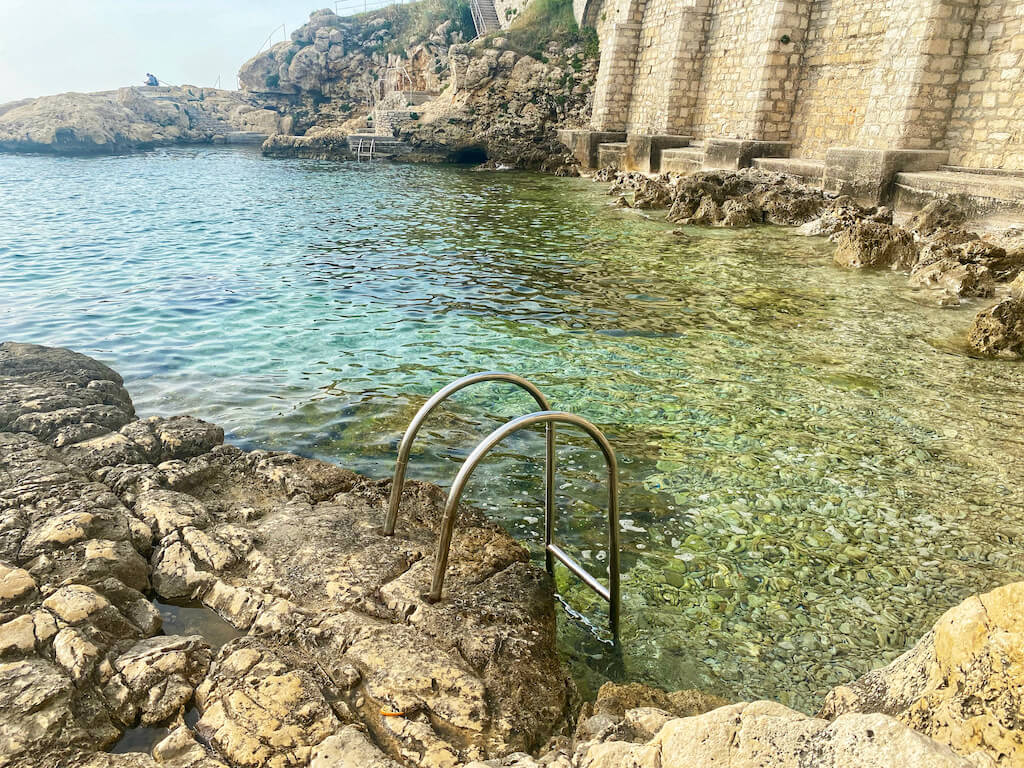
There are also excellent day trips from Rovinj.
You can head down the coast to Pula—about a 45 minute drive—to check out the Pula arena, the only remaining Roman amphitheater with four side towers entirely preserved.
It was constructed between 27 BC and AD 68 and is one of the six largest Roman arenas worldwide!
Otherwise, consider a day trip to nearby Istrian hill towns.
The most famous of them are Motuvun, Groznjan, Boljn, and Gracisce. We visited Motovun en route to our next destination, Plitvice Lakes National Park, as we headed inland.
But If you’d like to take a break from driving, consider booking a guided day trip to hill towns that includes a stop for homemade ravioli, truffle tasting, and an organic wine farm. You learn more about the day trip to Istrian hill towns tour here.
Motovun is one of Istria’s best preserved medieval hill towns. It’s a pretty sleepy place except for one week each summer when it goes wild with a film festival.
Walk the steep cobblestone path up to the castle, have a meal with a view or sip a sunset drink at Montona Gallery, the main bar in Motovun. It comes with epic views!
Konoba Mondo is famous here ever since Anthony Bourdain visited some years ago. You’ll see the New York Times review taped to the window.
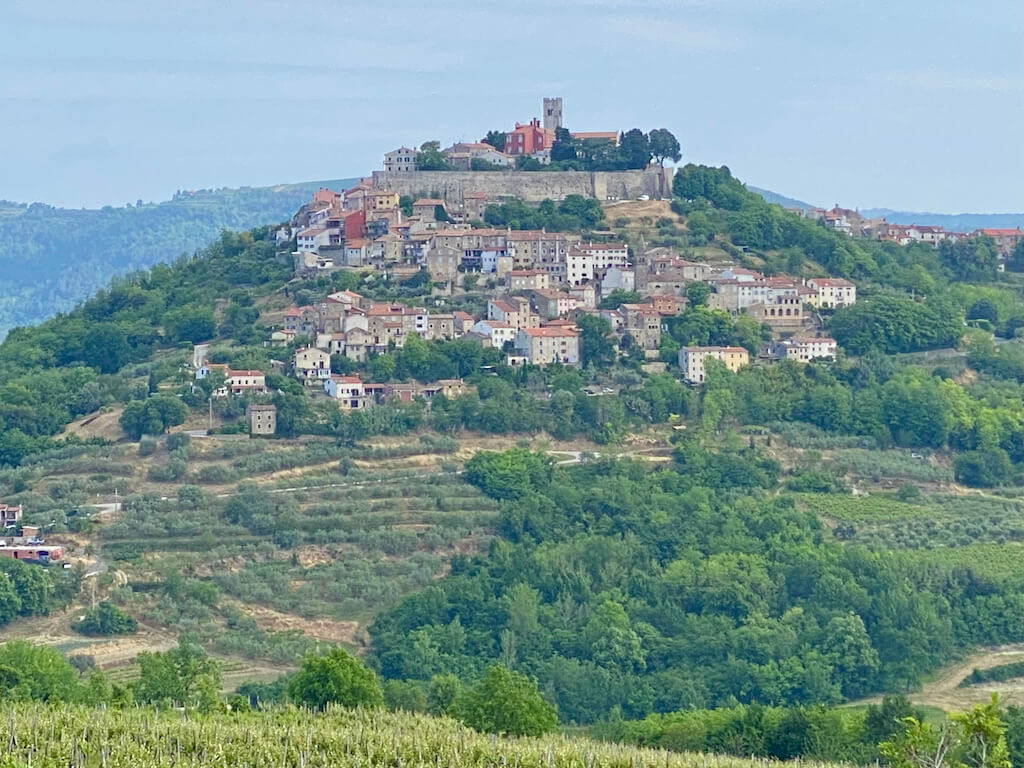
Plitvice Lakes National Park
It’s about a three hour drive from Rovinj on the Istrian Peninsula to the incredibly scenic Plitvice Lakes National Park in the interior of Croatia.
While all other sites on this Croatia road trip itinerary are along coastal Croatia, Plitvie National Park is a big detour inland.
And there’s a good reason why: It’s the #1 national park in Croatia!
This UNESCO World Heritage Site is quite simply spectacular with waterfalls tumbling over travertine walls into a network of clear turquoise lakes everywhere.
It’s actually Croatia’s #1 tourist destination. And because so many travelers visit Plitvice as a long guided day trip from Split, it can be seriously crammed with tourists in summer.
As a result, I think the best way to visit is to plan two nights here so you can be in the park early in the morning before everyone arrives mid-day.
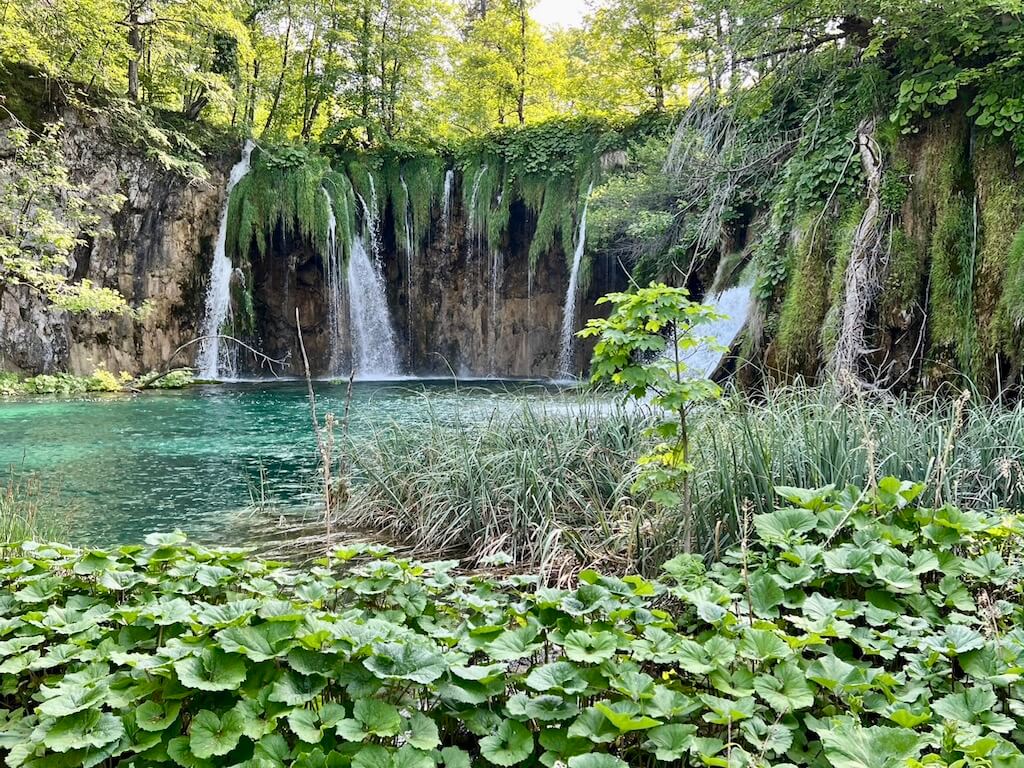
The park is divided into a lower falls loop and an upper falls loop.
Both are beautiful although I think most tourist groups head to the lower falls area which mostly leaves the upper falls quieter.
If you spend the night and get into the park early, you can do one loop in the morning, go for a hike or have a rest during the day and head back for the other loop late afternoon or early evening and have it all to yourself.
(The park tends to be swamped between 10 am to 2 pm.)
Be sure to make an advance reservation though. You’ll be asked for an entry time and to choose an entrance gate, which will depend upon where you’re staying.
Food options are not memorable here; even the grocery stores are small and basic so you may want to stock up on picnic supplies before arriving here.
Where to stay in Plitvice National Park
Stay at the Yeti Cabin
This was another candidate for our favorite stay in Croatia. The cabin is clean, spacious and rustic with a decent bed.
The best parts? Your private wildflower meadow. The hammock and picnic table behind the cabin overlooking waterfalls and a turquoise river.
And of course, Dorde, the most helpful host ever. It’s a 15 minute walk into Plitvice National Park from here.
Check price and availability at the Yeti cabin here.
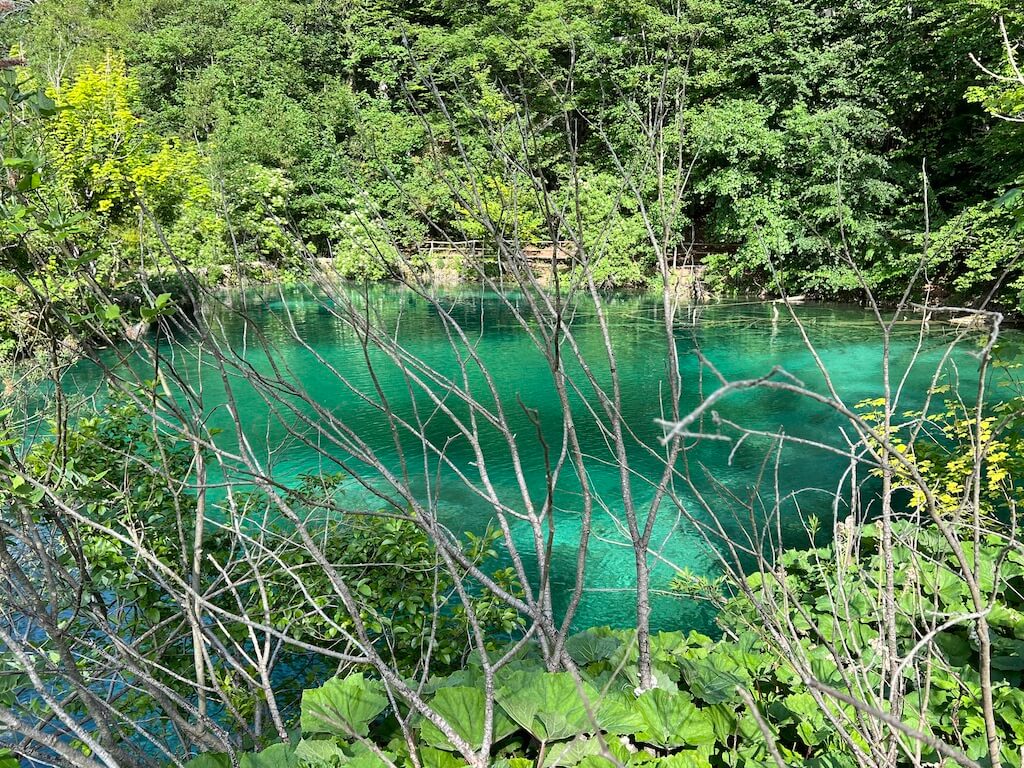
There are several country inn restaurants with garden settings close to the park. Just know that the emphasis is more on massive portions of country fare (meat, potatoes, vegetables) but you’ll get by!
The warm hospitality makes up for the lack of inventive cuisine.
Plitvice National Park is an absolutely unique and beautiful place to include on your itinerary although it’s admittedly out of the way.
If you’d rather stick to the coast and skip the extra drive time, Krka National Park is the next best thing and you can see it easily from Split. See below!
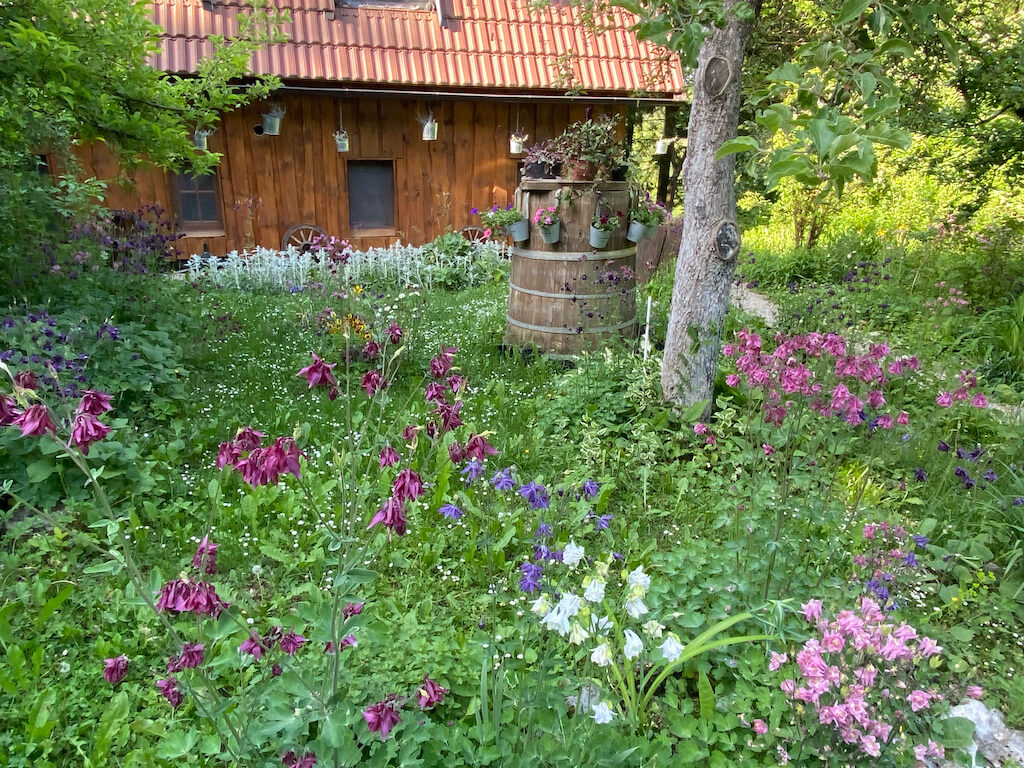
Split
Split makes a great base for the best of Dalmatia, Croatia’s sun-soaked central coast.
There are oodles of guided day trips you can do from Split if you’d like to take a break from driving…from seeing Plitvice and Krka National Parks to sailing trips and island hopping in the Adriatic.
Remember how I said I like to fortify myself for a long drive with an epic mid-way lunch destination?
Indeed. Zadar makes the perfect stop en-route from Plitvice National Parks.
First off, if you stop in Zadar, don’t miss the Zadar sea organ as we did.
I didn’t know this was a thing until later but the ocean waves here flow through an architectural “sound object” to create an experimental instrument powered by the sea. Woah!
In any case, I also had another one of my favorite Croatian meals here in Zadar at Pet Bunara. (Handy parking lot nearby.)
Everything was amazing…including a traditional moist cake for dessert that came with a citrus jam layer at the bottom that I also can’t stop thinking about!
Two entrees, wine, espressos and dessert came to $50 USD. I’d make a serious detour to eat again here…
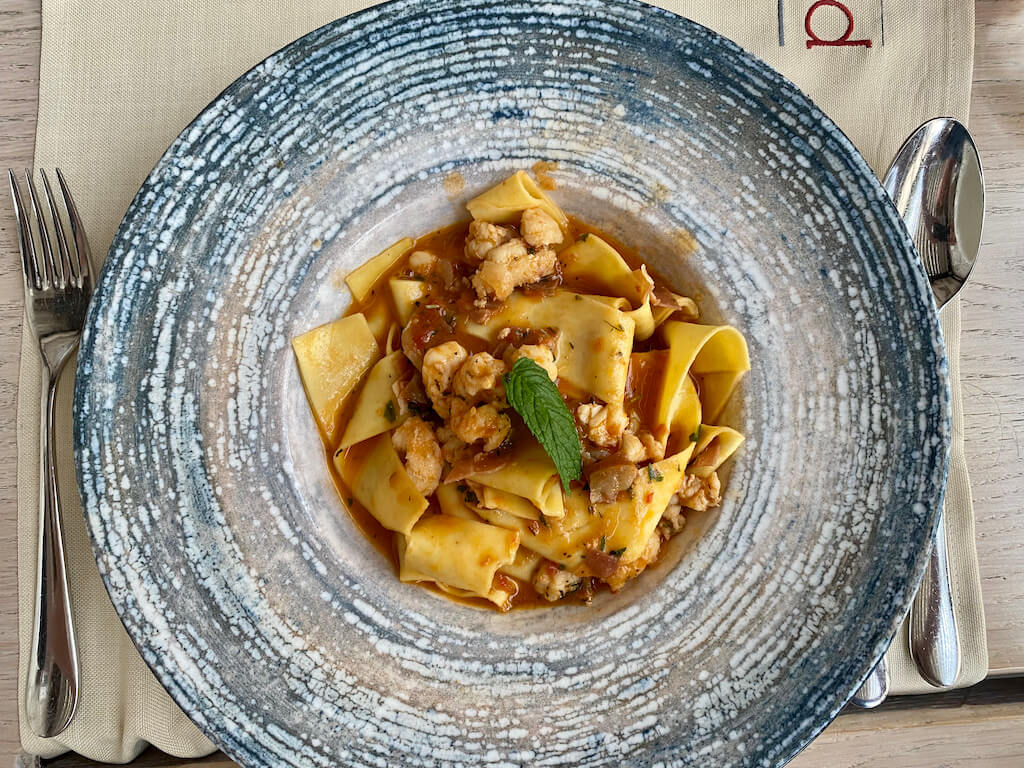
But I digress! The main attraction in Split is Diocletian’s Palace, built for the Roman emperor Diocletian in the early fourth centruy AD which makes it 1700 years today.
It’s a sprawling warren of romantic cobblestone alleys that covers 7.5 acres of marble and limestone.
Back in the day, it was originally two impressive structures in one spot: a luxurious villa and also a fortified Roman town.
Today, you can wander the ruins for free and actually stay inside the palace walls as well which is a unique and wonderful experience!
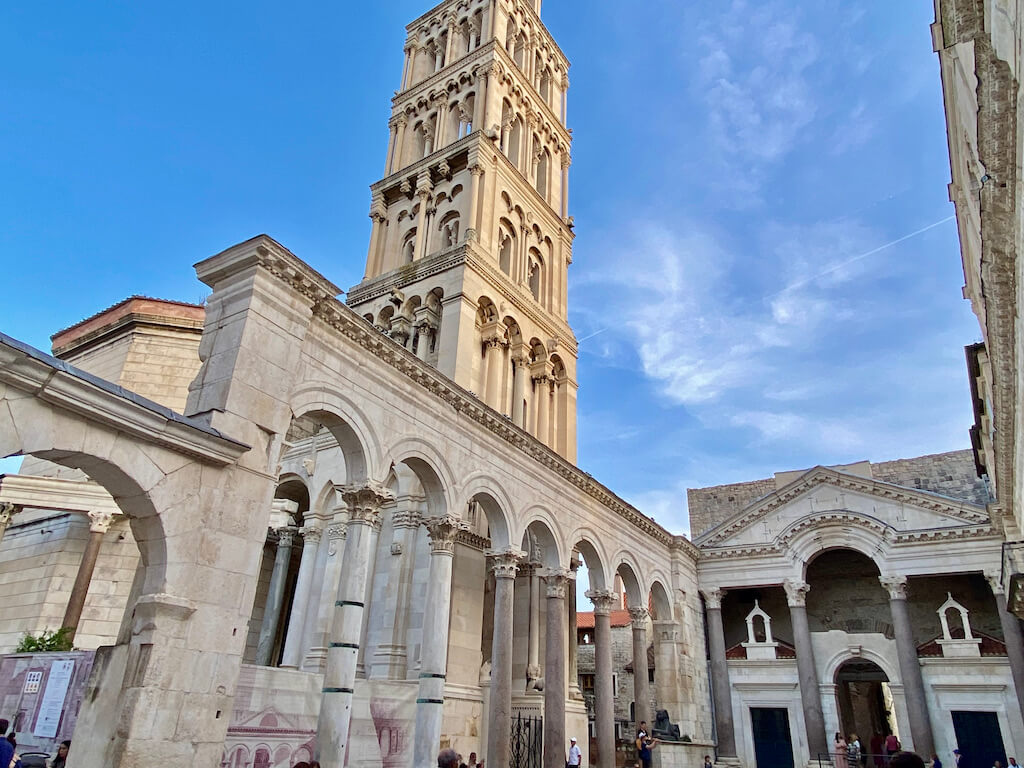
There are possibly more than 100 coffee shops, wine bars, restaurants, bakeries, and boutiques tucked inside Diocletian’s Palace. After dark, it oozes romance!
Just outside the palace is The Riva, a big long promenade along the harbour here which makes a great place for people watching.
Honestly, there’s lots of tacky tourist souvenir stands along here but it’s perfect for a glass of wine or a coffee to watch the ferries and sailboats bobbing in the sea.
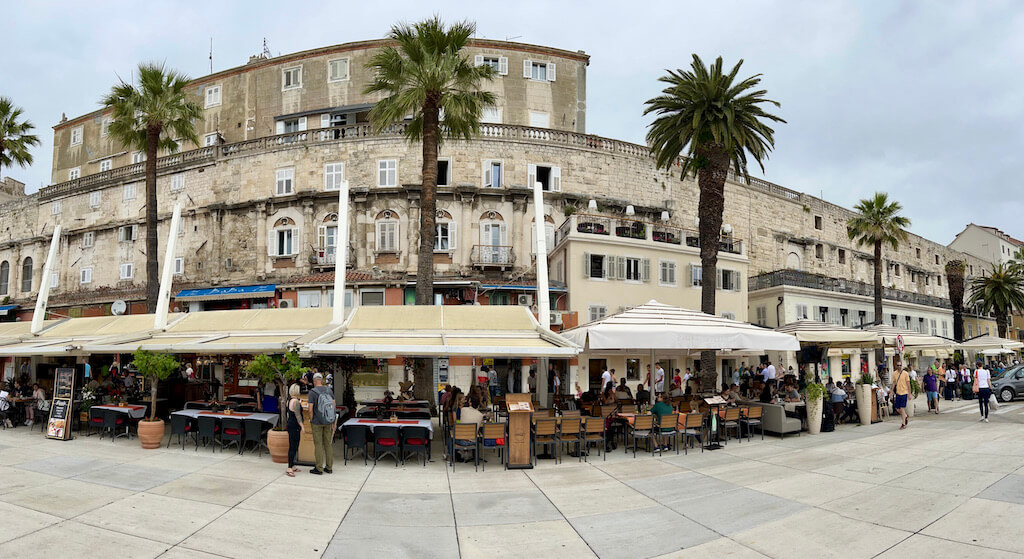
Where to stay in Split
Option 1: Stay inside the Diocletian’s Palace Walls
This is such a unique experience and I can’t say enough about our lovely Airbnb hostess Suzana. Her gorgeous little apartment is an excellent value, has air conditioning, and also one of the more comfortable beds we enjoyed in Croatia.
Plus, for a few extra kuna, she can arrange private parking for you which is, honestly, a Godsend in busy Split. (Just know that the parking is in a little stone courtyard and you’re going to have one of those European experiences folding in your car mirrors to squeeze in so prepare yourself.)
Check price and availability at Suzana’s Airbnb inside the Diocletian Palace here.
Option 2: Stay in car-friendly Trogir.
Not a fan of driving and parking in big cities like Split? Trogir is a 30 minute drive from Split if you’d like to skip the parking hassle and prefer a tiny scenic village to a sprawling metropolis.
This is also a great option for your return trip to Zadar!
Try Hotel Trogirski Dvori, a modern, quiet hotel, just a four minute walk from the beach.
Check price and availability at Hotel Trogirski Dvori in Trogir here.
Krka National Park
If you can’t get enough of those turquoise waterfalls after Plitvice National Park—or if you’ve decided to skip the long drive to Plitvice and back—Krka National Park makes an excellent and easy day trip from Split.
It’s an hour’s drive from Split and a little less from Trogir.
You can see Krka easily on your own or leaving the driving to someone else on a guided day trip. Check price and tour availability here.
Much like Plitvice, however, this place is packed with summer tourists mid-day so get an early start!
You likely don’t need advance reservations here.
If you’re driving, park at the entrance below the falls rather than above for better viewing.
You’ll take a scenic ferry ride for 30 minutes down the river and then can spend a half day wandering the park and seeing the falls.
Pack a lunch or grab something inside the park.

Korcula
You can’t go to Croatia without dipping into one of the dozens of islands here! This is your vacation from your vacation.
The most popular to visit are probably Hvar (pronounced “Hwar”) and Korcula (“Kor-chu-la”) and can be visited from Split or even a guided sailing day trip from Dubrovnik further south.
Hvar is closer to Split and has a vibrant night life and bar hopping scene as well as a Spanish fortress above Old Town.
It makes a good base for day trips to other islands as well.
We visited Korcula, just off the Plejesac Peninsula instead, which is considered a more relaxed, low key island.
In late May, summer tourism hadn’t yet ramped up which made it idyllic. The water is much warmer in June through September but crowds are much thicker.
I think September is probably the perfect time to visit as the water’s still warm but crowds have thinned out!

Where to stay on Korcula
Stay near Old Town.
We stayed in a lovely apartment with the stunning view above of Old Town and it never got old. However, the bed was not great. So I’m steering you to Apartments Giuliani which offers the same view but great reviews with a few mentions of the memory foam bed by travelers. 😉
Check price and availability at Apartments Giuliani in Old Town here.
You can actually catch a car ferry from Split to Korcula; it takes about two and a half hours to cross the sea.
Because we were traveling in shoulder season, there were fewer car ferries from Split, however, so we decided to drive several hours south to Orebić where they ran every half hour and the crossing took just 15 minutes.
Old Town is the place to be in Korcula.
It’s a beautiful jumble of stone buildings with an ancient cathedral and restaurants both inside and outside the walls.
Lots of fresh fish is on offer here. Be sure to taste test the local white wine Grk against Pošip, another beautiful white wine in abundance here.
Go wine tasting in Lumbarda or Vela Luka at either end of the island. Climb to the top of Massimo Cocktail Bar to sip your sunset cocktail in a turret.
Spend some time at one of the many beautiful beaches here.
We spent three nights on Korcula and I could’ve stayed forever…
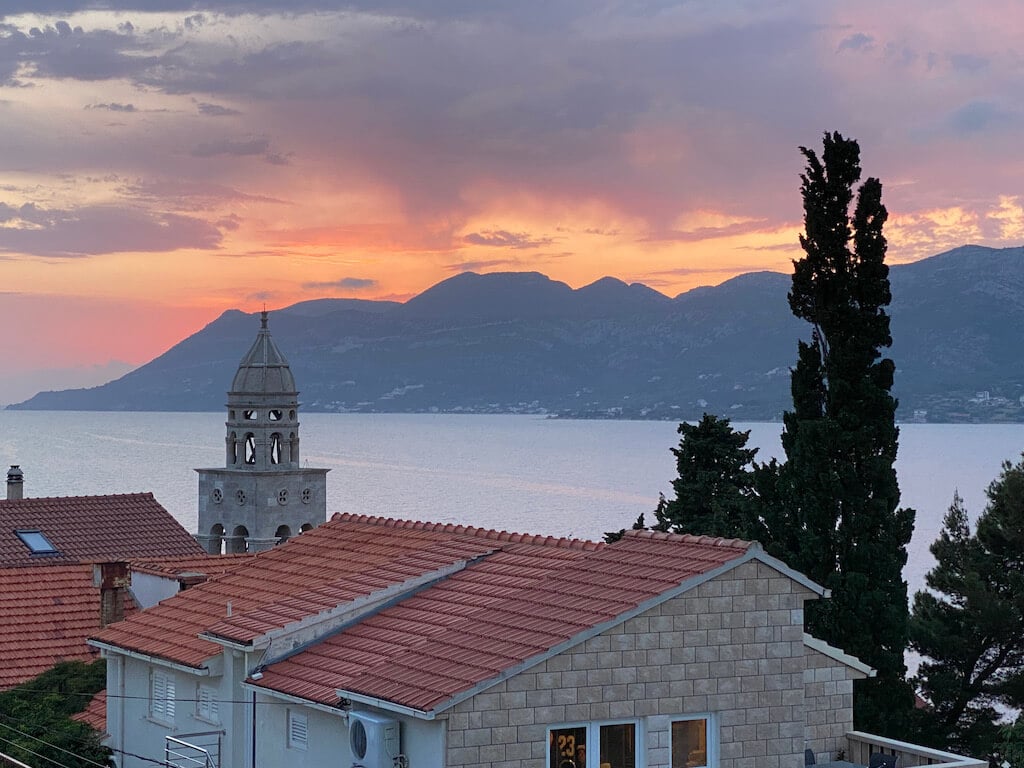
Dubrovnik
Dubrovnik is your last stop on the Croatia road trip.
It’s a two hour drive from Orebić if you’re just back from Korcula. You can either fly home from here or drive back to Zadar.
On our current trip, we didn’t make it this far south; I last visited Dubrovnik with family friends in 1985 when I was a university student from UC Santa Barbara in southern California studying in France for a year.
I still think about that trip all these years later. My friends were visiting long-lost Croatian relatives for the very first time and it was such an emotional reunion. People cooked for days for us before we arrived.
One of them even roasted lamb—my first taste—on a spit on the island of Brač near Split for us, proudly showing us their family quarry.
It wasn’t until this trip that I learned that all the stone to build the stunning Diocletian Palace came from quarries on Brač!
That was six years before Dubrovnik’s Old Town—even then a UNESCO “protected” site—was bombed back during former Yugoslavia’s war…an attack that shocked the world.
Fortunately, Dubrovnik was later rebuilt and restored.
Today, it’s become a hot international travel destination…full of Game of Thrones fans—16 filming locations are here—and destination weddings.
Where to stay in Dubrovnik
Option 1: In Dubrovnik
Stay at the beautiful restored Heritage Villa Nobile, just 450 feet from Pile Gate, a few minutes more to the Dubrovnik cable car, and a four minute walk to the beach. Full of character with A/C and breakfast on the lovely terrace + parking, what more could you want?
Check price and availability at Heritage Villa Nobile here.
Option 2: In nearby Lapad
Residential Lapad is just 15 minutes from Dubrovnik (or a 45 minute walk) and makes a great alternative to staying near busy Old Town. Beaches abound here.
Apartment Vista 2 is a 3 minute walk to the beach with an unbelievable view of the Adriatic from a private balcony.
Check price and availability at Apartment Vista 2 in Lapad here.
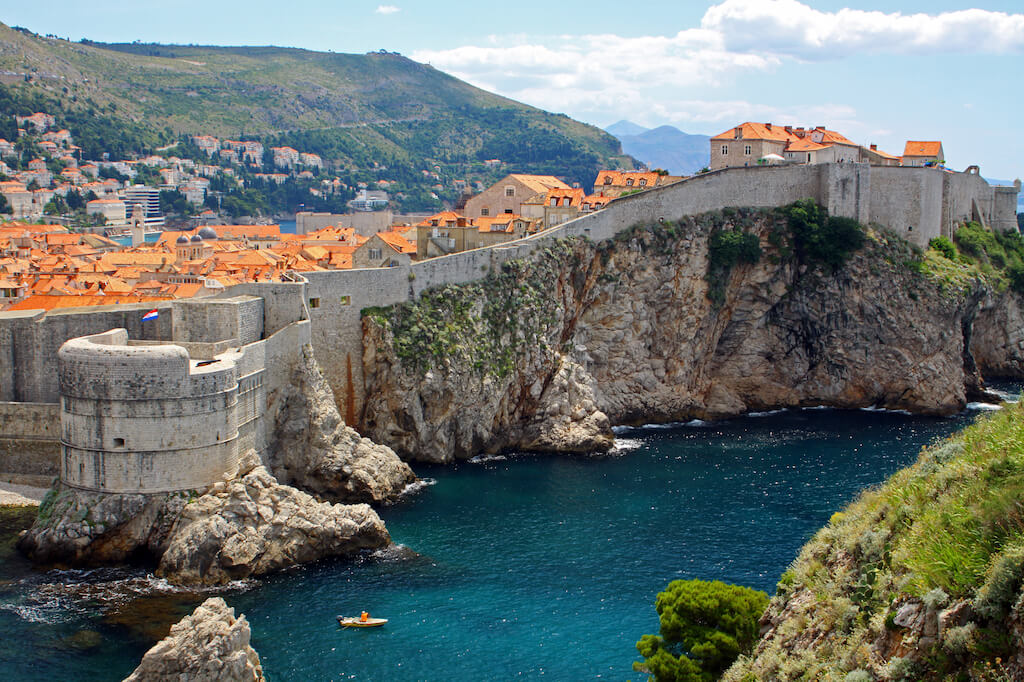
If you’ve never been, you should definitely include Dubrovnik on your Croatia itinerary.
It’s an ancient walled city like Diocletian’s Palace in Split but on steroids.
You can walk all the way around the massive 16th century stone walls here for views out to the gorgeous sea…but get here first thing if you want to enjoy it without the crowds! Even if you only have 2 days in Dubrovnik, be sure to walk the walls!
After you’ve explored Old Town, you can take a day trip to Lokrum Island just offshore (or a longer trip to Korcula), explore Fort Lovrijenac, and ride the Dubrovnik cable car up to Mount Srd. Or take a tour to the Elaphiti Islands.
A boat tour to the iconic Blue Cave is everybody’s favorite day trip but be sure to book on a smaller boat for a more intimate experience as this place can get crowded. Check price on availability on a tour here.
With more time, consider a scenic dip into nearby Montegro either on a guided day trip or driving on your own.
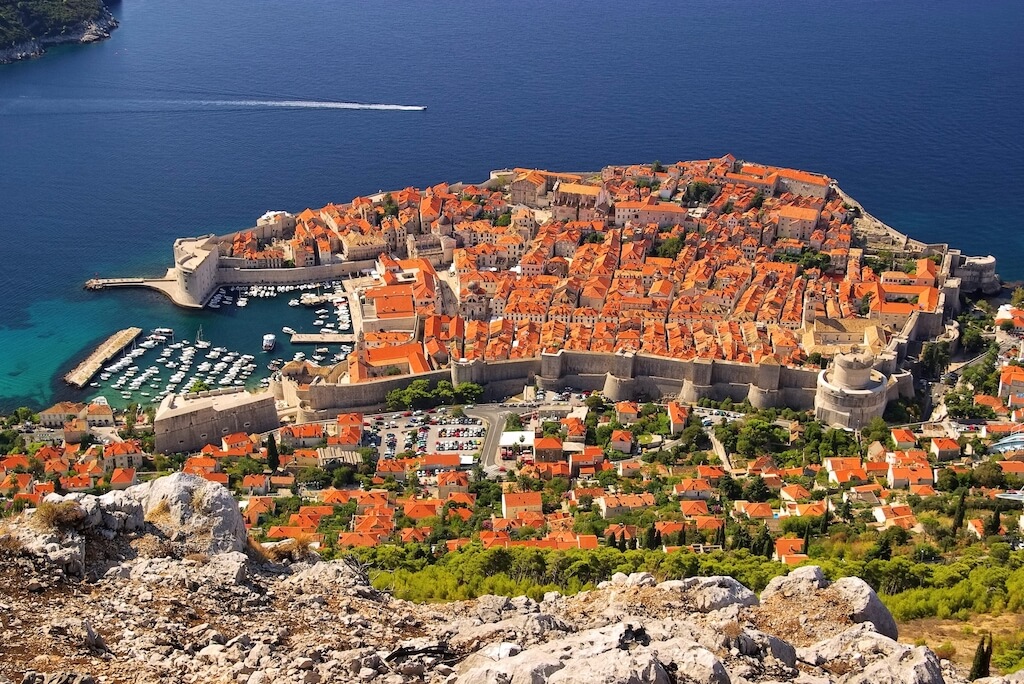
Your Croatia road trip is a wrap.
This Croatia itinerary is the best way I know to sample the very best of the country in just a short time. From its colorful Istrian Peninsula in the north to Dubrovnik, jewel of the Adriatic in the south, Croatia charms travelers always.
Wishing you the best trip ever.
Like this post? Pin it to save it for later!
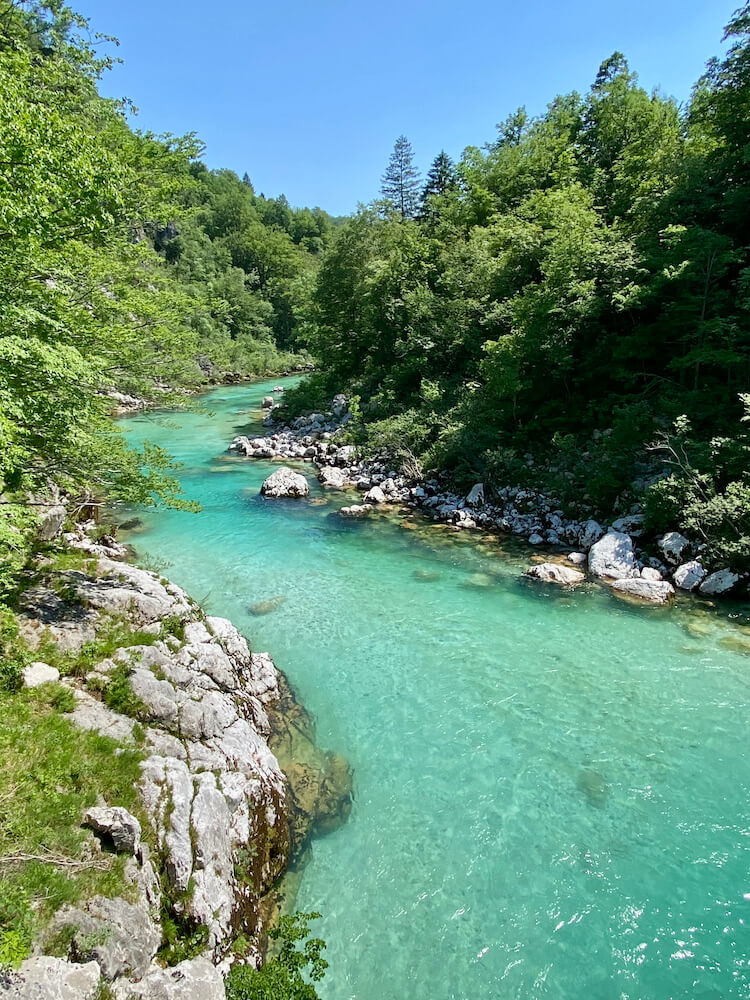
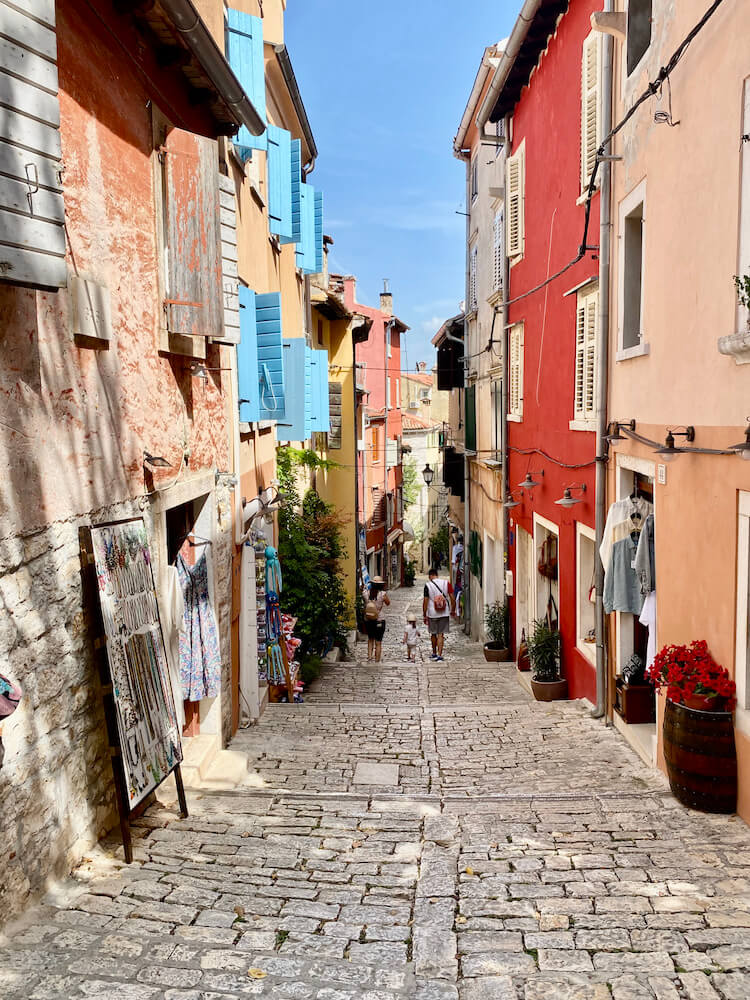
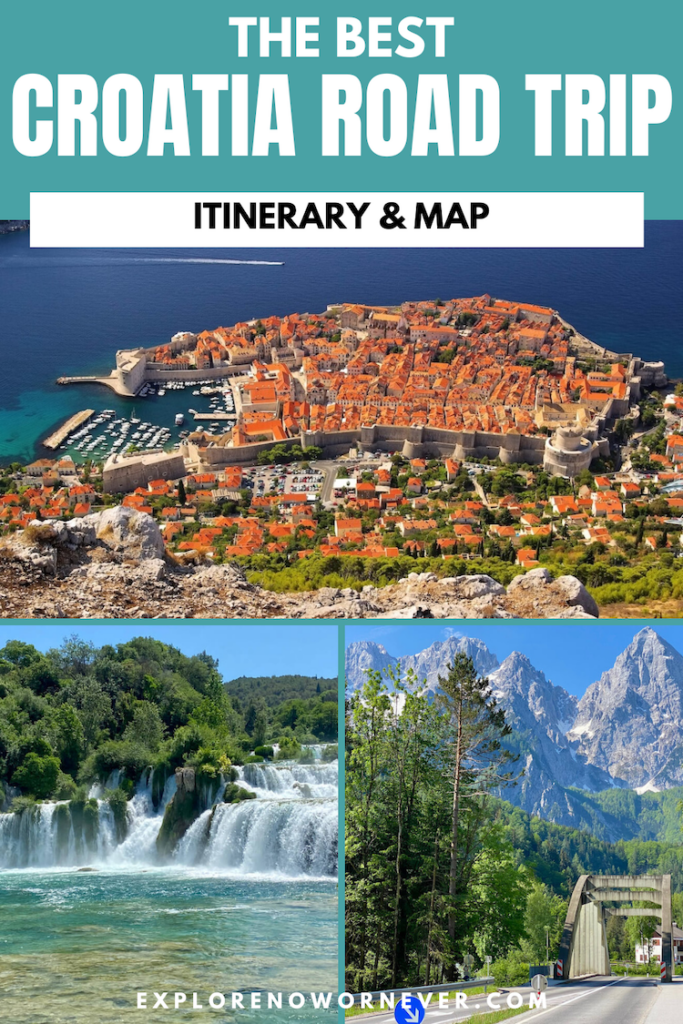
Leave a Reply